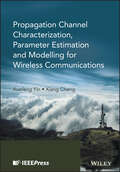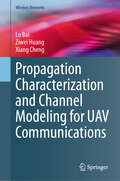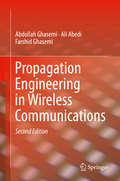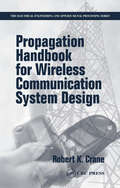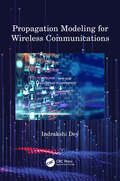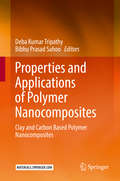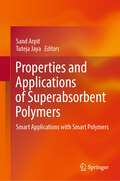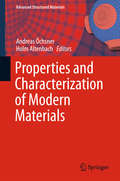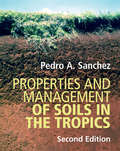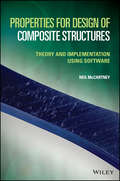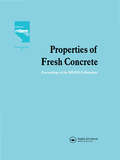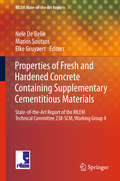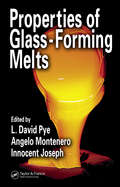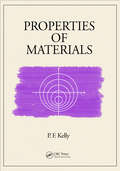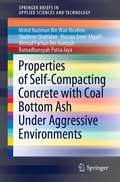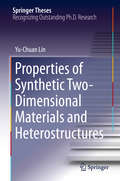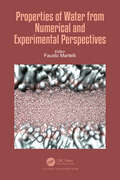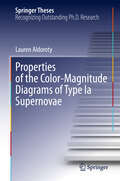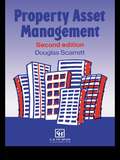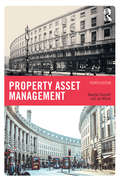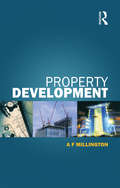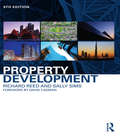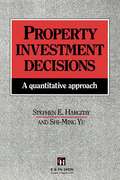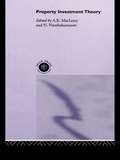- Table View
- List View
Propagation Channel Characterization, Parameter Estimation, and Modeling for Wireless Communications (Wiley - IEEE)
by Xiang Cheng Xuefeng YinA comprehensive reference giving a thorough explanation of propagation mechanisms, channel characteristics results, measurement approaches and the modelling of channels Thoroughly covering channel characteristics and parameters, this book provides the knowledge needed to design various wireless systems, such as cellular communication systems, RFID and ad hoc wireless communication systems. It gives a detailed introduction to aspects of channels before presenting the novel estimation and modelling techniques which can be used to achieve accurate models. To systematically guide readers through the topic, the book is organised in three distinct parts. The first part covers the fundamentals of the characterization of propagation channels, including the conventional single-input single-output (SISO) propagation channel characterization as well as its extension to multiple-input multiple-output (MIMO) cases. Part two focuses on channel measurements and channel data post-processing. Wideband channel measurements are introduced, including the equipment, technology and advantages and disadvantages of different data acquisition schemes. The channel parameter estimation methods are then presented, which include conventional spectral-based estimation, the specular-path-model based high-resolution method, and the newly derived power spectrum estimation methods. Measurement results are used to compare the performance of the different estimation methods. The third part gives a complete introduction to different modelling approaches. Among them, both scattering theoretical channel modelling and measurement-based channel modelling approaches are detailed. This part also approaches how to utilize these two modelling approaches to investigate wireless channels for conventional cellular systems and some new emerging communication systems. This three-part approach means the book caters for the requirements of the audiences at different levels, including readers needing introductory knowledge, engineers who are looking for more advanced understanding, and expert researchers in wireless system design as a reference. Presents technical explanations, illustrated with examples of the theory in practice Discusses results applied to 4G communication systems and other emerging communication systems, such as relay, CoMP, and vehicle-to-vehicle rapid time-variant channels Can be used as comprehensive tutorial for students or a complete reference for engineers in industry Includes selected illustrations in color Program downloads available for readers Companion website with program downloads for readers and presentation slides and solution manual for instructors Essential reading for Graduate students and researchers interested in the characteristics of propagation channel, or who work in areas related to physical layer architectures, air interfaces, navigation, and wireless sensing
Propagation Characterization and Channel Modeling for UAV Communications (Wireless Networks)
by Xiang Cheng Ziwei Huang Lu BaiThis book focuses on the propagation characterization and channel modeling of Unmanned Aerial Vehicle (UAV) communications. Currently, there are no books that cover this specific topic. The authors fill in this void by elaborating accurate yet easy-to-use UAV channel models. The authors also present such topics as propagation characteristics of UAV communications, a time stationary regular-shaped geometry-based stochastic model (RS-GBSM) for UAV narrowband channels. It also introduces a time non-stationary RS-GBSM for UAV narrowband channels, a time non-stationary RS-GBSM for UAV wideband channels, a time-space non-stationary irregular-shaped geometry-based stochastic model (IS-GBSM) for UAV wideband channels and more. Finally, this book closes up with some promising directions, hoping to promote future research outcomes in the field of UAV channel modeling. As the UAV technology matures rapidly, UAV communications are shifting from military development to civilian and commercial sectors. The UAV communication is widely considered as a significant and indispensable component of wireless communications. It is well known that an accurate yet easy-to-use UAV channel model is the foundation of designing a proper UAV communication system and evaluating its performance. This book also provides valuable suggestions for the design of UAV communication systems by adequately presenting the UAV propagation characterization and channel modeling. This book is mainly written for researchers and professionals working in wireless communications. Advanced-level students majoring in computer science or electrical engineering may also find the content useful as a secondary textbook.
Propagation Engineering in Radio Links Design
by Farshid Ghasemi Abdollah Ghasemi Ali AbediThis book addresses propagation phenomena in satellite, radar, broadcasting, short range , trans-horizon and several recent modes of communications in radio links. Also, it includes some topics on antennas , radio noises and improvement techniques. The book provides the necessary basic matters, as well as experimental results and calculation procedures for radio link design.
Propagation Engineering in Wireless Communications
by Farshid Ghasemi Abdollah Ghasemi Ali AbediPropagation Engineering in Wireless Communications covers the basic principles needed for understanding of radiowaves propagation for common frequency bands used in radio-communications. This book includes descriptions of new achievements and new developements in propagation models for wireless communication. The book is intended to bridge the gap between the theoretical calculations and approaches to the applied procedures needed for radio links design in a proper manner. The authors intention is to emphasize propagation engineering by giving sufficient fundamental information and then going on to explain the use of basic principles together with technical achievements in this field.
Propagation Handbook for Wireless Communication System Design (Electrical Engineering & Applied Signal Processing Series)
by Robert K. CraneData and models for better systems designAtmospheric gases, building materials, the weather � The propagation of wireless communications signals depends upon a whole range of factors, any or all of which can have a significant impact on the quality of a signal. Data generated by careful measurement of signals propagating under various envir
Propagation Modeling for Wireless Communications
by Indrakshi DeyThis book introduces the various approaches and tools used for modelling different propagation environments and lays the foundation for developing a unified theoretical framework for future integrated communication networks. In the case of each type of network, the book uses basic concepts of physics, mathematics, geometry and probability theory to study the impact of the dimension and shape of the propagation environment and relative transmit-receive position on the information flow. The book provides an introduction into wireless communication systems and networks and their applications. For both systems and networks, the basic hard (encoder, modulator, etc.) and soft components (information, signal, etc.) are discussed through schematic block diagrams. Next each of the modes of communication, namely radio waves, acoustic waves, magnetic induction, optical waves, biological particles (molecules, aerosols, neural synapse etc.) and quantum field, are discussed. For each communication scenario presented, the impact of different environmental factors on the propagation phenomenon is articulated, followed by different channel modelling (deterministic, analytical, and stochastic) techniques that are used to characterize the propagation environment. Finally future trends in wireless communication networks are examined and envisioned for next generations 6G/7G of communication systems, like space information networks, sea-to-sky internet of vehicles, and internet of bio-nano things. Based on the future trends of integrated networks, the book drives the need for a generalized channel model irrespective of the media and mode of information transfer. The primary audience for the book is post-graduate students, researchers and academics in electronics and communications engineering, electrical engineering and computer science.
Properties and Applications of Polymer Nanocomposites
by Deba Kumar Tripathy Bibhu Prasad SahooThe aim of the present edited book is to furnish scientific information about manufacturing, properties, and application of clay and carbon based polymer nanocomposites. It can be used as handbook for undergraduate and post graduate courses (for example material science and engineering, polymer science and engineering, rubber technology, manufacturing engineering, etc. ) as well as as reference book for research fellows and professionals. Polymer nanocomposites have received outstanding importance in the present decade because of their broad range of high-performance applications in various areas of engineering and technology due to their special material properties. A great interest is dedicated to nanofiller based polymeric materials, which exhibit excellent enhancement in macroscopic material properties (mechanical, thermal, dynamic mechanical, electrical and many more) at very low filler contents and can therefore be used for the development of next-generation composite materials.
Properties and Applications of Superabsorbent Polymers: Smart Applications with Smart Polymers
by Sand Arpit Tuteja JayaThis book discusses fundamental aspects of super absorbent polymers (SAPs), insight into the synthesis and modification of SAPs as well as their potential applications in different domains.SAPs are bio-based material that has attracted much interest due to their unique structural properties, biodegradability, biocompatibility, etc. The book exhibits a unique combination of SAP designing, synthetic strategies, properties and chemistry along with SAP’s application in the field of drug delivery, firefighting and biosensors, agriculture, etc. Various approaches to make these products a cost-effective and sustainable are discussed precisely in this book. Additionally, the approaches from the perspective of academic organization and research laboratories, many readers are able to learn the insights of the connection between super absorbent polymers in the agriculture field by reducing seedling mortality owing to their water storage capacity in soil. This book written by eminent researchers can be a useful reference for graduate, post-graduate students and researchers working in the file of super absorbent polymers, polymer technology, hygiene industry, etc.
Properties and Characterization of Modern Materials
by Andreas Öchsner Holm AltenbachThis book focuses on robust characterization and prediction methods for materials in technical applications as well as the materials' safety features during operation. In particular, it presents methods for reliably predicting material properties, an aspect that is becoming increasingly important as engineering materials are pushed closer and closer to their limits to boost the performance of machines and structures. To increase their engineering value, components are now designed under the consideration of their multiphysical properties and functions, which requires much more intensive investigation and characterization of these materials. The materials covered in this monograph range from metal-based groups such as lightweight alloys, to advanced high-strength steels and modern titanium alloys. Furthermore, a wide range of polymers and composite materials (e. g. with micro- and nanoparticles or fibres) is covered. The book explores methods for property prediction from classical mechanical characterization-related fields of application, for example, from wear, creep, fatigue and crack growth, to specific surface properties, to dielectric and electrochemical values. As in all fields of modern engineering, the process is often accompanied by numerical simulation and optimization.
Properties and Management of Soils in the Tropics
by Pedro A. SanchezThe long-awaited second edition of this classic textbook expands on the first edition to include advances made in the last four decades, bringing the topic completely up to date. The book addresses critical issues such as whether humanity can feed itself, and whether it can do so in environmentally sound and sustainable ways. Written from agronomic, environmental, and ecological standpoints, the textbook employs a multidisciplinary approach, including policymaking and plant genetic improvements, as well as ecosystem services, climate change, biodiversity, sustainability and resilience. New chapters in this second edition focus on organic carbon in soil, soil biology, soils in relation to livestock production and forestry, and agroforestry. The new edition will again be the go-to textbook for courses on tropical soils, and a reference textbook for soil and agricultural scientists and development professionals working in the tropics.
Properties for Design of Composite Structures: Theory and Implementation Using Software
by Neil McCartneyPROPERTIES FOR DESIGN OF COMPOSITE STRUCTURES A comprehensive guide to analytical methods and source code to predict the behavior of undamaged and damaged composite materials In Properties for Design of Composite Structures: Theory and Implementation Using Software, distinguished researcher Dr. Neil McCartney delivers a unique and insightful approach to the development of predictive methods for the properties of undamaged and damaged laminated composite materials. The book focuses on presenting compact analytical formulae for several important effective properties—including mechanical, thermal, and electrical—that can be applied to a variety of reinforcement geometries. The author introduces a compact notation that enables an explicit treatment of laminate property determination, including the out-of-plane shear properties required for three-dimensional numerical simulations of structural features using finite and boundary element analyses. There is also a detailed consideration of ply crack closure and a useful study of the interrelationships between the effective thermoelastic constants of damaged laminates. The book also offers: A thorough introduction to the principles and formulae for homogenous materials and applications, including continuum and fracture concepts for homogeneous materials A comprehensive exploration of the properties of undamaged composites, including undamaged composite materials with multiple phases and the properties of a single undamaged lamina Practical discussions of the properties of damaged composites, including matrix cracking in UD composites and damaged laminates Consideration of effects of delamination, fatigue, and environmentally induced damage In-depth examinations of derivations of key results, including the analysis of bridged cracks and stress transfer mechanics for cross-ply and general symmetric laminates Perfect for composite design engineers in all types of material-supplying industries and manufacturing companies, Properties for Design of Composite Structures: Theory and Implementation Using Software will also earn a place in the libraries of undergraduate and graduate students in engineering, aerospace, and materials departments.
Properties of Fresh Concrete: Proceedings of the International RILEM Colloquium
by H. J. WierigThis book presents new information on concrete properties and production in the light of the widespread use of ready mixed concrete and new concreting materials. This book forms the Proceedings of the RILEM Colloquium held in Hanover, West Germany in October 1990. Papers from 18 countries in Europe, North America and the Far East are included.
Properties of Fresh and Hardened Concrete Containing Supplementary Cementitious Materials: State-of-the-art Report Of The Rilem Technical Committee 238-scm, Working Group 4 (RILEM State-of-the-Art Reports #25)
by Nele De Belie Elke Gruyaert Marios SoutsosThis volume represents the current knowledge on the effect of SCMs (slag, fly ash, silica fume, limestone powder, metakaolin, natural pozzolans, rice husk ash, special SCMs, ternary blends) on the properties of fresh and hardened concrete (e.g. early strength development, workability, shrinkage) and curing requirements. Other topics treated in the book are postblending vs preblending, implications of SCM variability, interaction between SCM and commonly used admixtures (e.g. superplasticizers, air entrainers).
Properties of Glass-Forming Melts
by L. David Pye Angelo Montenero Innocent JosephThis book presents state-of-the-art information concerning properties and processes involved in glass melts. Based upon contributions by renowned authors and scientists working with glass melt systems, Properties of Glass-Forming Melts is an excellent compilation of the current knowledge on property data, mechanisms, measurement techniques, and str
Properties of Materials
by P.F. KellyThe second volume in the author's three-part series, Properties of Materials uses the principles of classical mechanics to qualitatively and quantitatively model specific features of matter.The text develops linear models of elasticity to correlate and quantify the changes in an object's shape induced by the application of a constant force. It desc
Properties of Self-Compacting Concrete with Coal Bottom Ash Under Aggressive Environments (SpringerBriefs in Applied Sciences and Technology)
by Shahiron Shahidan Mohd Haziman Bin Wan Ibrahim Hassan Amer Algaifi Ahmad Farhan Bin Hamzah Ramadhansyah Putra JayaThis book highlights the importance of incorporating coal bottom ash (CBA) into self-compacting concrete exposed to aggressive conditions. The incorporation of CBA in concrete is a sustainable strategy to prolong the lifespan of concrete. The content of the book is also regarded as a solution to the environmental issue. It helps academics, researchers, and students to acquire a better understanding of the influence of coal bottom ash on the properties of concrete through four sequential chapters. The book first presents background information on concrete deterioration, and then the improvement in properties of self-compacting concrete with different percentages of CBA exposed to tap water, sulphate solution, chloride solution, and seawater.
Properties of Synthetic Two-Dimensional Materials and Heterostructures (Springer Theses)
by Yu-Chuan LinThis book represents a significant advance in our understanding of the synthesis and properties of two-dimensional (2D) materials. The author’s work breaks new ground in the understanding of a number of 2D crystals, including atomically thin transition metal dichalcogenides, graphene, and their heterostructures, that are technologically important to next-generation electronics. In addition to critical new results on the direct growth of 2D heterostructures, it also details growth mechanisms, surface science, and device applications of “epi-grade” 2D semiconductors, which are essential to low-power electronics, as well as for extending Moore’s law. Most importantly, it provides an effective alternative to mechanically exfoliate 2D layers for practical applications.
Properties of Water from Numerical and Experimental Perspectives
by Fausto MartelliAs the most important liquid in our life and one of the most abundant molecules in the universe, water is the least understood substance with a very rich phase diagram (at least 18 crystalline forms and two liquids) and more that 60 dynamical/thermodynamic anomalies whose origins are still under debate. Properties of Water from Numerical and Experimental Perspectives gathers together leading scientists and experts in the field of water. By merging the theoretical/computational point of view with experimental approaches, it presents a state-of-the-art description of the properties of water, enlightening the source of the anomalies of water and describing how such anomalies actively affect the functioning of biological substances.
Properties of the Color-Magnitude Diagrams of Type Ia Supernovae (Springer Theses)
by Lauren AldorotyThis thesis presents a novel analysis of a photometric observational feature of Type Ia Supernovae (SNe Ia), the most precise distance indicators available for cosmological studies. While SNe Ia are crucial for understanding modern cosmology, there are systematic uncertainties associated with them that prevent use to their full potential. It is therefore vital that sources of systematic error in SN Ia standardization are better understood. In this thesis, the author robustly connects the color-magnitude diagram to SN Ia spectra and their physics for the first time, and shows that for the SN sample in the dissertation, this feature is important to consider as a contributor to scatter in the Hubble residual. There is no prior work in the literature that examines this feature in such depth, and it is rare to be able to paint such a thorough picture in a SN Ia study rooted in a single photometric feature. This work opens up many avenues for future observational and theoretical studies.
Property Asset Management
by D. ScarrettProperty has unique characteristics, both as an investment and as an operational holding. A thorough understanding of this dual role is needed by professionals responsible for maximising a property's full potential. Property Asset Management emphasizes the need for a strategic plan in property management as well as for efficient day-to-day practice.
Property Asset Management
by Douglas Scarrett Jan WilcoxProperty asset management requires both day-to-day oversight of rental properties and an ability to maximize the potential of the portfolio through forward thinking and practical planning. Successful property managers must be flexible and proactive whilst maintaining a robust knowledge of technical, financial and legal aspects of the leasing system. Property Asset Management is a practical guide to the key principles of successful property management, perfect for both student and practitioner alike. In this book, Douglas Scarrett and Jan Wilcox demonstrate how to successfully manage properties for the varying needs of clients ranging from individual property owners to large international commercial ventures. As well as the basic theory, Property Asset Management discusses the process of active management, the strategic objectives, performance measurement, and the key financial and operational information needed for high quality and comprehensive reporting to clients. This fourth edition has new chapters on corporate real estate and financial management, and has been extensively rewritten to incorporate recent developments in property management. Software screenshots are used to illustrate salient points and readers are provided with a thorough overview of the latest legal aspects of land ownership and tenancy arrangements. With everything you need for successful property asset management, this book both caters for the needs of RICS accredited and business courses and serves as a handy guide for everyday practice.
Property Development
by Alan Millington"Property Development" includes such considerations as the objectives, functions, roles and methods of operation of all those involved in the development process, the financial aspects of development, social considerations, planning matters, and others, providing readers with the opportunity to develop their understanding of and their expertise in, the subject.
Property Development
by Richard Reed Sally SimsThe 6th edition of this extremely popular and classic textbook has been updated to reflect ongoing changes in the field of property development. Attention is paid to the impact of the global financial crisis on the property development process and, in addition, to the increasing relevance of technology to the property profession. Whilst the successful style and format of the text has been retained, new chapters have been added and existing chapters updated and enhanced to guide lecturers and students in their teaching, reading and studying. Other new features in this edition include: Fully updated discussion points and reflective summaries Examples of contemporary best practice based on international case studies covering the UK, USA and Australia New chapters on 'Property Cycles' and 'Technology' Online materials for lecturers and students This fully revised edition of a standard text for all property development and real estate students will also be of interest to early career professionals and those pursuing similar professional degrees in the industry and in wider built environment courses.
Property Investment Decisions: A quantitative approach
by S. Hargitay S Hargitay S-M YuThe importance of property as an investment medium continues to grow. Investors in property or those involved with the provision of expert advice to investors have had to improve the effectiveness and efficiency of their decision making. The aim of this book is to lay down the theoretical foundations of investment decision making, incorporating the techniques and procedures of modern management science, so that particular decisions regarding property investment can be made efficiently and rationally.
Property Investment Theory
by A. R. MacLeary N. NanthakumaranThis up-to-date reference on property investment highlights the problems with existing techniques of property valuation and appraisal and identifies possible ways forward for both research and practice.
